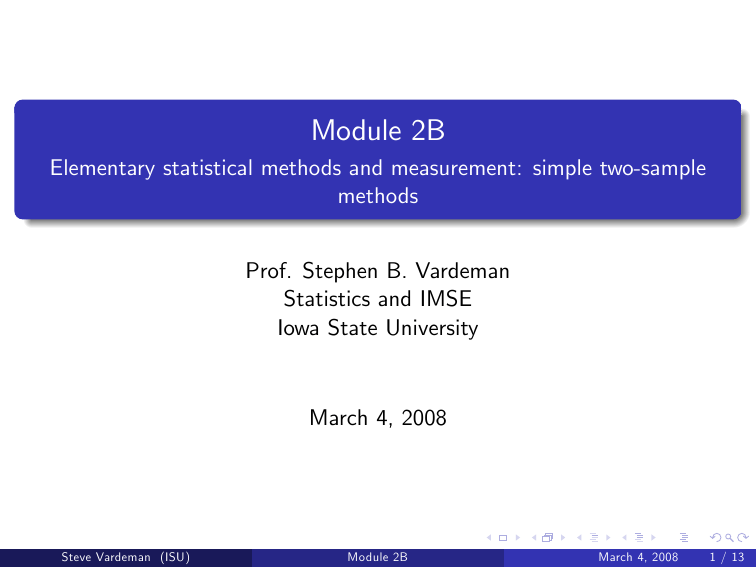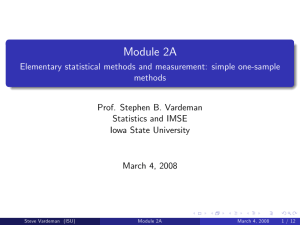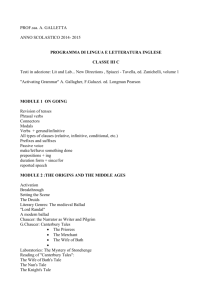Module 2B Elementary statistical methods and measurement: simple two-sample methods
advertisement

Module 2B Elementary statistical methods and measurement: simple two-sample methods Prof. Stephen B. Vardeman Statistics and IMSE Iowa State University March 4, 2008 Steve Vardeman (ISU) Module 2B March 4, 2008 1 / 13 Basic CI Formulas for Two (Independent) Samples These are based on a model that says that y11 , y12 , . . . , y1n1 and y21 , y22 , . . . , y2n2 are samples from normal distributions with means µ1 and µ2 and standard deviations σ1 and σ2 . The "Satterthwaite approximation" gives limits s s12 s2 + 2 for estimating µ1 µ2 , y 1 y 2 t̂ n1 n2 where "approximate degrees of freedom for t̂ are ν̂ = s12 s2 + 2 n1 n2 2 s14 s24 + (n1 1)n12 (n2 1)n22 A simple conservative version of this method uses ν̂ = min ((n1 1), (n2 Steve Vardeman (ISU) 1)) . Module 2B March 4, 2008 2 / 13 Basic CI Formulas for Two (Independent) Samples (cont.) Further, in the two-sample context, there are elementary con…dence limits s1 s2 q 1 F(n 1 1 ),(n 2 1 ),upper and s1 s2 q 1 F(n 1 for 1 ),(n 2 1 ),lower σ1 . σ2 (F(n1 1 ),(n2 1 ),lower = 1/F(n2 1 ),(n1 1 ),upper so that standard F tables giving only upper percentage points can be employed.) Steve Vardeman (ISU) Module 2B March 4, 2008 3 / 13 Four Applications Four di¤erent ways that two "samples" of n1 observed values y1 and n2 values y2 might arise are as repeat measurements of a single measurand made using two di¤erent devices, single measurements made with two devices on multiple measurands from a stable process (only one device being used for a given measurand), repeat measurements made with one (linear) device on two measurands, and single measurements made using a single (linear) device on multiple measurands produced by two stable processes. Steve Vardeman (ISU) Module 2B March 4, 2008 4 / 13 Repeat Measurements of a Single Measurand Made Using Two Di¤erent Devices Here the t interval is for δ1 Steve Vardeman (ISU) δ2 and the F interval is for σdevice1 /σdevice2 . Module 2B March 4, 2008 5 / 13 Example 2B-1 Measuring Styrofoam "Packing Peanut" Size. In an in-class measurement exercise, two students used the same caliper to measure the "size" of a single Styrofoam "packing peanut" according to a class-standard measurement protocol. Summary statistics are Student 1 n1 = 4 y 1 = 1.42 cm s1 = .20 cm Student 2 n2 = 6 y 2 = 1.44 cm s2 = .40 cm Here, the di¤erence in "devices" is the di¤erence in "operators" making the measurements. Let’s compare"devices." To begin, !2 (.20)2 (.40)2 + 4 6 ν̂ = 7.7 (.20)4 (.40)4 + (4 1) (4)2 (6 1) (6)2 Steve Vardeman (ISU) Module 2B March 4, 2008 6 / 13 Example 2B-1 (cont.) Or being more conservative, ν̂ = min ((4 1), (6 1)) = 3. So (rounding the …rst down to 7) one should use either 7 or 3 degrees of freedom in the t formula. For sake of example, using ν̂ = 3 degrees of freedom, the upper 2.5% point of the t distribution with 3 df is 3.182. So 95% con…dence limits for the di¤erence in biases for the two operators using this caliper are s (.20)2 (.40)2 + 1.42 1.44 3.182 4 6 i.e. .02 cm .61 cm The apparent di¤erence in biases is small in comparison to the imprecision associated with that di¤erence. Steve Vardeman (ISU) Module 2B March 4, 2008 7 / 13 Example 2B-1 (cont.) Then, since the upper 2.5% point of the F3,5 distribution is 7.764 and the upper 2.5% point of the F5,3 distribution is 14.885, 95% con…dence limits for the ratio of standard deviations of measurement for the two operators are 1 .20 .20 p p 14.885 and .40 .40 7.764 i.e. .19 and 1.93 Since this interval covers values both smaller and larger than 1.00, there is (in the limited information available here) no clear indicator of which of these students is the most consistent in his or her use of the caliper in this measuring task. Steve Vardeman (ISU) Module 2B March 4, 2008 8 / 13 Single Measurements Made With Two (Linear) Devices On Multiple Measurands From a Stable Process (Only One Device Being Used for a Given Measurand) Steve Vardeman (ISU) Module 2B March 4, 2008 9 / 13 Single Measurements Made With Two (Linear) Devices On Multiple Measurands From a Stable Process (Only One Device Being Used for a Given Measurand) (cont.) Here q the t interval q is for δ1 δ2 and the F interval is for 2 2 σx + σdevice1 / σ2x + σ2device2 . The t interval is important when measurement is destructive and the previous data collection plan can’t be used, and is typically less informative (for a given pair of sample sizes) than the previous method when both can be used. The F interval provides (only) a somewhat indirect comparison of the two device precisions. Steve Vardeman (ISU) Module 2B March 4, 2008 10 / 13 Repeat Measurements Made With One (Linear) Device On Two Measurands Here the t interval is for x1 Steve Vardeman (ISU) x2 . Module 2B March 4, 2008 11 / 13 Single Measurements Made Using a Single (Linear) Device on Multiple Measurands Produced by Two Stable Processes Here the t interval is for µx 1 Steve Vardeman (ISU) µx 2 . Module 2B March 4, 2008 12 / 13 Single Measurements Made Using a Single (Linear) Device on Multiple Measurands Produced by Two Stable Processes (cont.) q + σ2device / q The F interval estimates σ2x 2 + σ2device and provides an (only) indirect comparison of process precisions. Steve Vardeman (ISU) σ2x 1 Module 2B March 4, 2008 13 / 13

